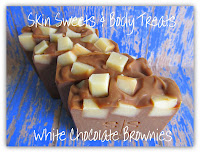M & P: Melt and pour. Melt and pour soap has so many possibilities and is the easiest way to soap in my opinion. There is no danger in dealing with lye because this kind of soap comes to you "pre-made." I would order my m & p soap in 25 lb blocks of either glycerin or basic white base. It was unscented and uncolored. Just a big block of soap. From that, I was able to cut off what I needed, scent it, color it and pour into any shape of mold that I wanted to. Scenting and coloring with melt and pour is pretty straight forward. Other than a few fragrances that discolor, you can get very vibrant colors because there is no "saponification" process to go through; it has already gone through that process it when it was made. Make sense? No?



Here are some of my melt & pour creations
Now let's move on to cold process soap making.
Cold Process soap making is creating soap by turning fatty oils into soap through a process called saponification. How do we turn common, food grade oils such as olive oil, coconut oil, palm oil, etc. into soap? Well, we have to cause a chemical reaction and this is done by adding lye (sodium hydroxide) into the mix. Sodium hydroxide is very dangerous to work with, which is why I was so nervous about having it in the house with kids and pets. Fortunately, now that I have a separate workspace I no longer worry about having it in the house. Lye is typically used to clean drains. A lot of people think that if it is such a dangerous "ingredient" then why in the world would I put that on my skin! Let me just be clear about this "ALL SOAP IS MADE WITH LYE." You can't have soap without lye. Lye simply creates the chemical process. After 24 hours, or when the saponification process is complete, nearly all the lye has left the soap. Also, cold process soap has to cure. Cure times vary between 4 weeks to 12 weeks. Certain types of soap are best after being cured for 6 - 12 months (castile soap, or 100% olive oil soap). It's during this cure time that the remaining lye dissipates, the soap evaporates any excess water and becomes a harder bar of soap. Ph levels also come down so that it is gentle for your skin.
And here are a few of my cold process soaps.
Now let's move on to HP soap making, or Hot Process. Let me back up for a second. Cold process soap making is called "cold process" because you use no outside heat source to make soap this way. So then, can you guess what HOT process soap making means? You guessed it; you add a heat source. Adding a heat source to "cook" your soap speeds up the saponification process. Some will say you can use the soap right away once it's set up and cut. I still like to add a cure time even to my hot process soaps because they do become firmer the longer they cure, but technically, they are safe to use after about 24 hours. Hot process soap making, in my opinion, produces a more rustic looking bar of soap. It tends to be clumpy and lumpy and makes it hard to get a color fully incorporated. At least that is my experience but I only have a couple batches under my belt. The pictures below show the phases the soap goes though as it cooks. You can see it turns a darker color as it heats up. This soap is being cooked in a crock pot.
See the soap heating up around the edges?
Almost completely heated up
Completely heated through or "gelled"
At this point you will lye test your soap and then you can incorporate fragrance and coloring .
Here are my hot process soaps. See how they are a bit more rustic looking? Some soapers only use this method and they are absolutely gorgeous. Mine? Not so much, but I'm okay with that.
There is also something call CPOP, or Cold Process Oven Process. This is a combination of the two. Soap is made using the cold process method and then it's placed into the oven for about 24 hours. Being subjected to heat for a period of time speeds up saponification too. I've only done this once and it didn't work out very well!!
So there you have it. I tried to be brief but sill give you enough information so that you know the process of soap making. Now this is where I tell you that hand made soap is absolutely the best kind of soap for your skin. Not because of anything special I do, it's just the nature of hand made soap. It's gentle, it's made with oils and butters that your skin loves. It's NOT commercially produced and it's absolutely NOT a detergent (unlike that stuff you buy in the store).
This completes a very basic knowledge of soaping. Hopefully you are leaving this blog enlightened and not confused. :)








